
In today’s digital age, online reviews have become an indispensable tool for both consumers and businesses. With over 95% of shoppers relying on online reviews to make informed purchasing decisions, businesses can no longer overlook the power of these digital testimonials. How reviews influence sales is the only question.
A recent study by Northwestern University’s Spiegel Research Center delved into the intricacies of online reviews and their impact on consumer behavior. The study revealed a wealth of insights that can guide retailers in leveraging online reviews to drive sales and enhance customer satisfaction.
The Spiegel Research Center’s findings underscore the influence online reviews have on purchase decisions. Consumers perceive reviews as authentic and unbiased opinions from fellow shoppers, making them a trusted source of information. This credibility translates into a significant impact on consumer behavior, with reviews influencing everything from product selection to brand perception.
According to the study, displaying reviews can increase conversion by 270%. And this isn’t just for products with a ton of reviews: products with 5 reviews had a purchase likelihood nearly 4X higher than products with no reviews. See below for other highlights and more data.
The Spiegel Research Center study unearthed several key findings that shed light on the dynamics of online reviews and their impact on purchase decisions. These findings provide valuable insights for retailers to effectively utilize online reviews in their marketing strategies:
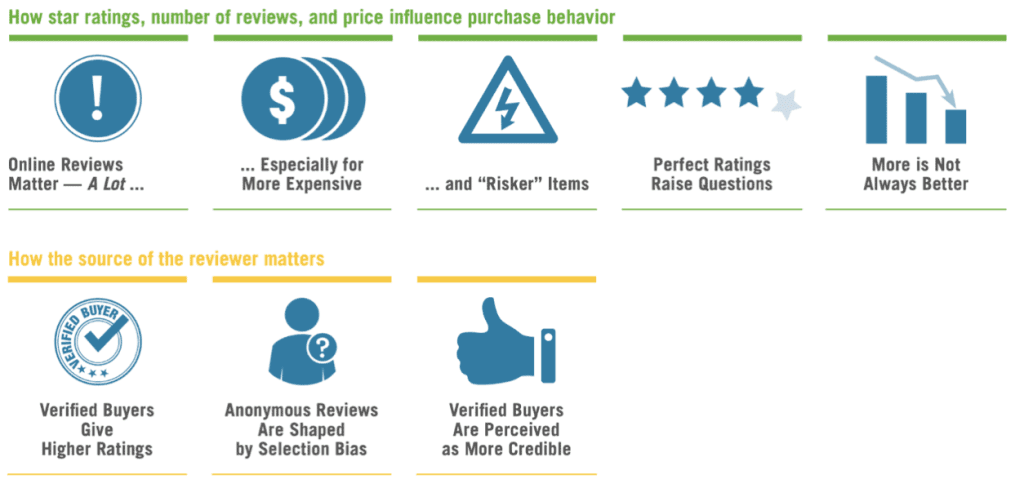
Read on for a detailed analysis of each of the findings.
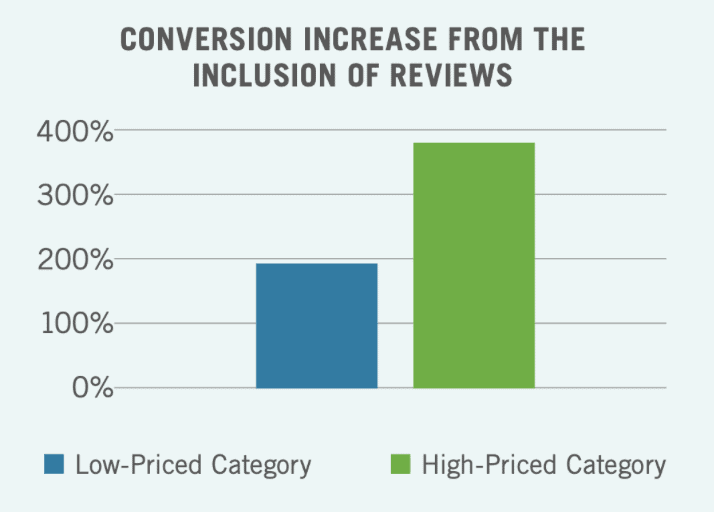
Reviews play a more prominent role in influencing purchase decisions for higher-priced items. Including reviews on high-priced items increased conversion by 370%, while including reviews on low-priced items increased conversion by 190%. This makes sense: consumers tend to conduct more in-depth research for expensive products, placing greater reliance on reviews to mitigate the perceived risk associated with such purchases.
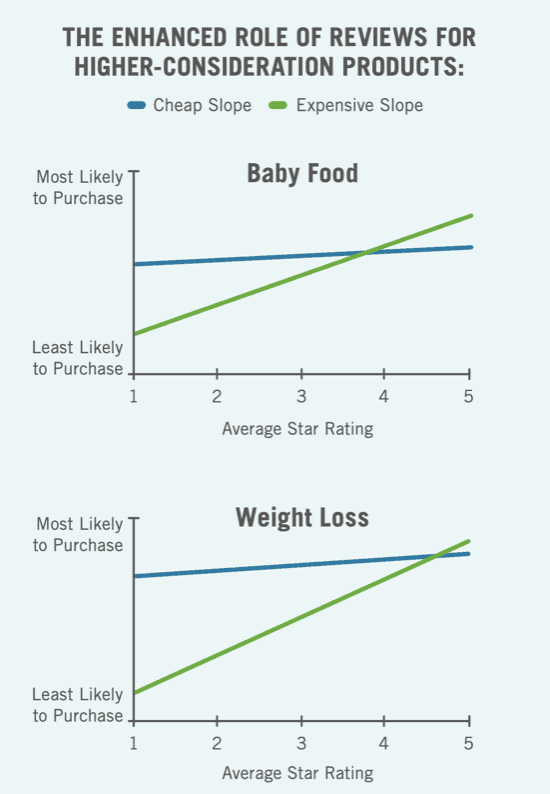
Reviews have a stronger impact on purchase likelihood for products that require more consideration. “Consideration” in this case means products that are more substantial purchases in terms of their impact on the purchaser’s lives. This “Consideration” aspect combines with the price aspect to make online reviews even more important for high-consideration and expensive purchases. In addition to price, factors such as potential health implications, personal identity expression, and recurring purchases elevate the importance of reviews in guiding consumer decisions.

While higher star ratings generally translate into increased sales, the study found that purchase likelihood peaks at ratings between 4.0 and 4.7. Across products, the optimal rating varies, and there are no categories for which the optimal rating is 5.0. Ratings approaching 5.0 tend to raise suspicions, leading consumers to question the authenticity of such seemingly perfect reviews, especially for expensive items like high-end gifts.
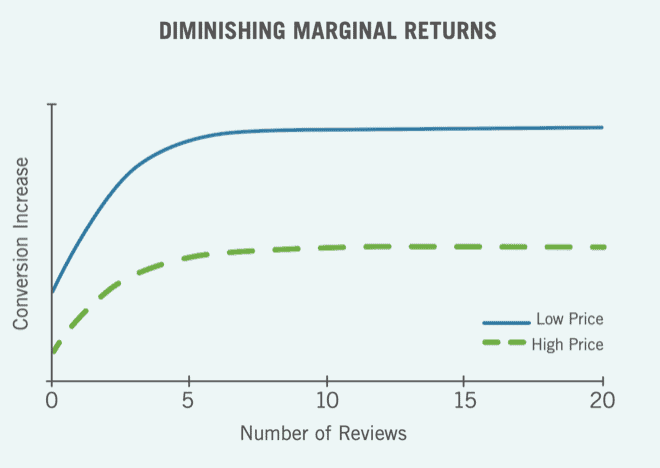
The initial reviews for a product have a disproportionate impact on shaping consumer perception and purchase decisions. The study found that nearly all of the increase in purchase likelihood occurs within the first 10 reviews. Retailers should prioritize encouraging early reviews to establish a positive foundation for their products, and then not worry too much about getting reviews after that. However, it is important to note that if your recent reviews bring down your star score, then getting more positive reviews is still worthwhile to bring up your score.
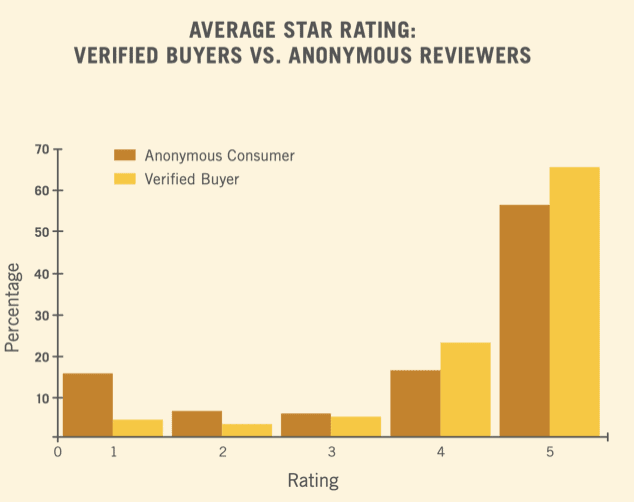
In the study, Verified Buyers were consumers who purchased a product online and were prompted to review it. And the study found that ratings from Verified Buyers were substantially higher than ratings from anonymous reviewers. This is great for retailers because Verified Buyers are perceived as more credible sources of information, leading to their reviews carrying greater weight in influencing purchase decisions. Retailers should encourage and incentivize Verified Buyer reviews whenever possible.

The research presented in this study offers valuable insights into how reviews influence sales. By translating these findings into actionable strategies, retailers can unlock the full potential of online reviews, driving sales and enhancing customer satisfaction.
The most important takeaway from this post is that having online reviews increases sales: leveraging reviews effectively can lead to a significant 270% increase in sales on average. You should integrate star ratings and customer testimonials seamlessly into all product pages and even checkout pages to reinforce the positive social proof. Make sure that your reviews are also visible on mobile to cater to the growing mobile shopping audience.
Counterintuitively, negative reviews can be beneficial. They foster trust and authenticity, demonstrating to potential customers a commitment to transparency and genuine product representation on your product pages. You can counter any negative feedback in the negative reviews by responding promptly and professionally to them on review platforms, which further reinforces your dedication to customer satisfaction.
As we saw above, the difference between 0 and 10 reviews is massive, and then falls off after that. Therefore, getting to 10 reviews is critical. Focus on generating reviews for products with low review volume and new additions. Use incentives to generate these if you have to, such as giving away the product for free or offering in-product benefits to people that click a link out to the review page.
For expensive products, new brands, or items impacting personal health and safety, reviews play an even more crucial role. Consumers rely heavily on reviews to mitigate risk and make informed decisions in these big purchases. Implement targeted strategies to encourage reviews for these high-stakes categories, such as email prompts or post-purchase incentives.
A large pool of reviews doesn’t always guarantee accurate representation, especially when dominated by extreme positive or negative opinions. Encourage Verified Buyers to leave reviews through targeted post-purchase prompts. Verified Buyer badges enhance the credibility of reviews and have been shown to increase purchase likelihood by 15%. Just make sure you’re doing all of this above board – transparency in how you identify and solicit Verified Buyer reviews is key to maintaining trust.
Online reviews influence sales and have become one of the most powerful forces in the online retail landscape. By understanding the dynamics of online reviews and implementing effective strategies, retailers can leverage these digital testimonials to drive sales, enhance customer satisfaction, and ultimately achieve business success.

Setting SMART goals is a valuable way to achieve progress and structure your professional development. If you’re not making progress towards your goals, looking for a way to be more productive, feeling lost or unsure of what constitutes success, or working with a team on a complex project, formatting your objectives in SMART goal format …

In today’s corporate landscape, the importance of women in corporate boards cannot be overstated. It’s not just about meeting a quota or ticking a box; it’s about driving better corporate governance and, ultimately, making more informed business decisions. Countless studies have shown that companies with more women in corporate boards are financially stronger, more innovative, …

Women continue to confront a persistent gender pay gap, putting the goal of pay equity in jeopardy. This disparity is evident across various occupations, even in those predominantly occupied by women, where they earn less than their male counterparts for the same roles. The gender pay gap, a multifaceted issue, is not just a matter …